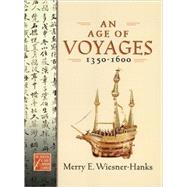An Age Of Voyages, 1350-1600
, by Wiesner-Hanks, Merry E.- ISBN: 9780195176728 | 0195176723
- Cover: Hardcover
- Copyright: 6/23/2005
Cultural life flowered from the mid-fifteenth century in the Italian city-states, many of which profited from the new trading opportunities that growing world networks permitted. Contact among regions of the world expanded, bringing new ideas and prompting an appreciation of arts andletters-not only of the present but of the past. In Italy this cultural flowering was known at first as the renaissance of arts and letters, soon shortened to just "Renaissance" to accommodate cultural ingredients that came from beyond Europe. Italian and northern European cultural expansionbenefited from similar retrieval of ancient knowledge in the Islamic world and East Asia. Like the Italians, the Chinese had grown even wealthier from the extensive links to global commerce provided by the Mongol Empire, but once thrown off, their cultural life flourished under the Ming. Culturalknowledge and the arts spread across Asia and into Europe. As part of state-building, the Ming nourished commerce but also rejected the cosmopolitan Buddhist legacy that arrived from central and south Asia. To strengthen dynastic Chinese rule, the Ming challenged Buddhism with a revival of age-oldconcern for the Confucian values that had languished under the Mongols. Foremost among these new Confucians was Wu Yube, so expert in his teachings that he attracted a wide coterie of disciples. In India, Nanak, an educated employee of an Afghan prince, sparked the founding of Sikhism. A similarsearch for reviving fundamental religious values occurred in Europe, where Martin Luther challenged the practices of the Catholic church, ushering in Protestantism. Religious reform and resistance to it were closely connected to the state-building efforts of enterprising monarchs such as Henry VIIIof England. India likewise experienced a fervent movement to revive pure, ancient religious practices. Fourteenth and fifteenth century global trade and long-distance ventures such as those made by the Ming and then by the Portuguese further inspired and advanced these worldwide cultural andpolitical developments. A brisk Indian Ocean trade flourished. Economic change ensued with the arrival of New World silver on the global market. The advance of printing not only furthered the cause of religious reform and state-building globally; it also helped globalize knowledge and intellectualexperimentation. People of great power and those of more limited means came to live their lives differently because of this expanding web of shared knowledge and trade. Cities flourished, the enslavement of native Americans came to replace their use as human sacrifices, and diseases migrated at amore rapid pace and greater devastation than perhaps ever before.







